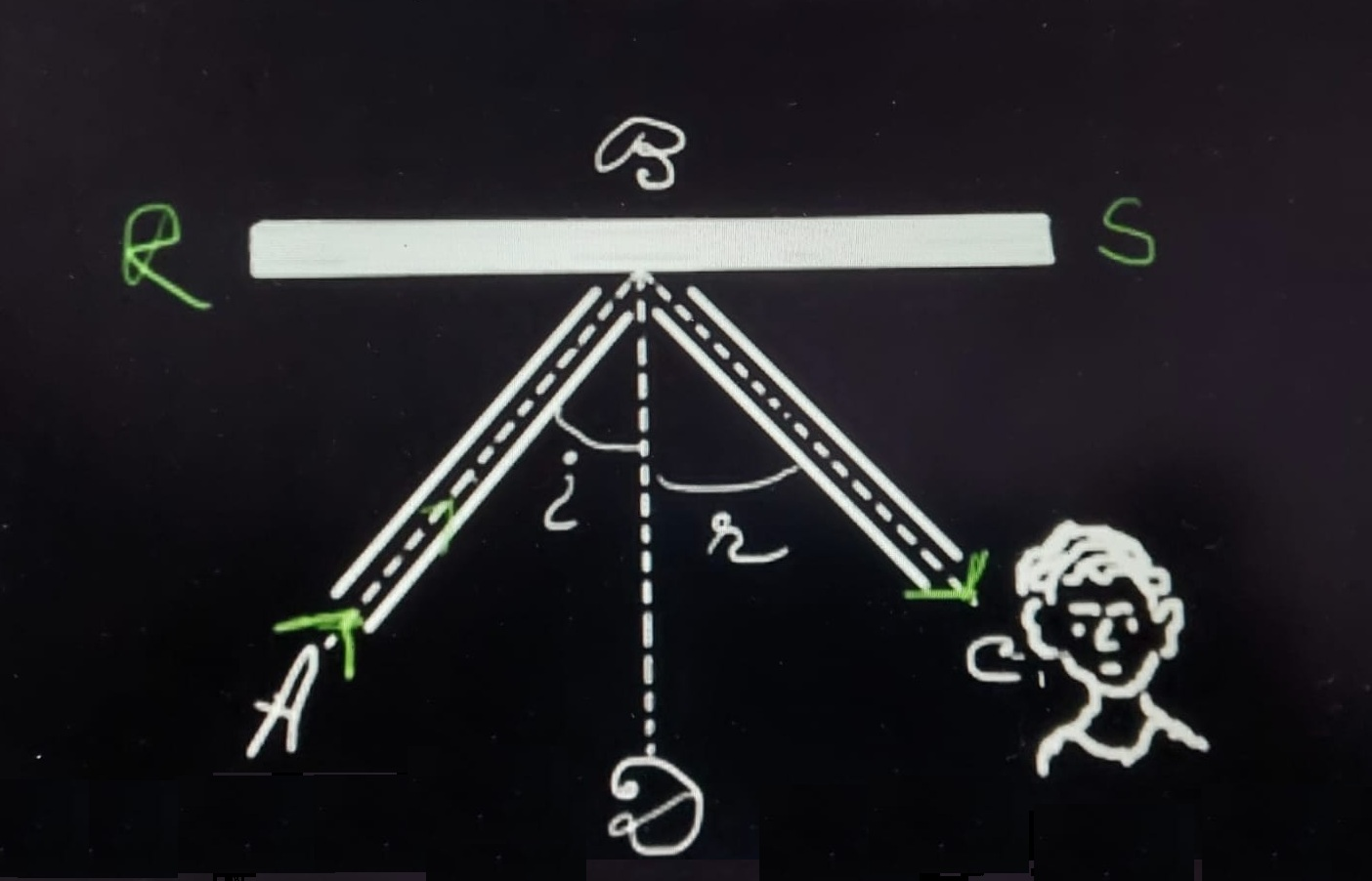When a sound wave moves through one medium and encounters a large obstacle such as a wall, mountain, or tall tree, it bounces back into the original medium after hitting the surface. This process is known as the reflection of sound.

The incident sound wave AB incident on point B and it is obstructed by the reflector RS it returns back along the way BC. So BC is the reflected wave.
\(\angle ABD\) represents the angle of incidence, denoted as \(\angle i\), while \(\angle CBD\) represents the angle of reflection, denoted as \(\angle r\).
There are two laws of reflection of sound.
i) The incident sound wave AB, reflected sound wave BC and the normal drawn at the point of the incident on the reflecting surface BD lie on the same plane.
ii) The angle at which the wave strikes the surface is equal to the angle at which it reflects off the surface.
\(\angle i \)=\(\angle r \)
Practical application of reflection of sound:
i) For hearing the sound coming from very far we often place our palm in a curved manner beside the ear. The sound coming from the distant place is reflected by the palm and heard very distinctly and clearly.
ii) Stethoscope. In a doctor's stethoscope, the sound of heart bid is received and this sound is reflected several times in the tube of the stethoscope, and heard clearly by the doctor.
Echo: The repeated sound produced by the reflection of original sound by a distant reflector and that is heard distinct by and separately from the original sound is called echo of the sound.
Persistence of hearing: Any short sound or momentary sound persists in our brain \(\frac{1}{10}\) sec. The sound of the gun, the sound of bombing, etc are called sort sounds or momentary sounds. This is an inarticulate sound. So the sound of the gun, the sound of the bombing are inarticulate sound. This type of sound remains in the human brain for about \(\frac{1}{10}\) of a second. An articulate sound remains in the human brain for about \(\frac{1}{5}\) of a second. The sounds which have to be felt by the listener is called articulate sound. Our dialog, our singing, our recitation, etc are articulate sounds.
Any word with only one syllable is called a monosyllabic word.
Ex: Pen is monosyllabic.
Any word with two-syllable is called a disyllabic word.
Ex: Pencil is disyllabic.
Any word with three-syllable is called a trisyllabic word.
Ex: Tendulkar is trisyllabic.
Any monosyllabic articulate sound persists \(\frac{1}{5}\) sec in the human brain. Disyllabic articulate sound persists \(\frac{2}{5}\) sec and trisyllabic articulate sound persist \(\frac{3}{5}\) sec in the human brain. But any short sound persists in the human brain for \(\frac{1}{10}\) sec. So hearing the echo of a momentary sound it must persist in the human brain at least \(\frac{1}{10}\) s. Before completion of \(\frac{1}{10}\) sec, if the echo comes back, that can't be heard by the listener.
Velocity of sound in air at \(0^{o}\) C is 332m/s. But temperature is not found \(0^{o}\) C all the time. So average velocity of sound in air is considered as 340m/s. Therefore in 1/10 sec sound travels 340 \(\times\) \(\frac{1}{10}\) m i.e 34 m.
The minimum distance between the reflector and the source will be \(\frac{34}{2}\) m i.e 17 m for hearing the echo of short sound.
For the monoarticular sound minimum distance between the reflector and the source will be 34 m. To produce a distinct echo, the minimum required distance between the sound source and the reflecting surface should be 64 meters. For denticulate sound, it will be 128 m.
Practical use of echo: SONAR(Sound Navigation and Ranging) is the technique to use the measurement of the depth of the sea, detection of shool of fish in see, detection of the mountain under the see, etc.